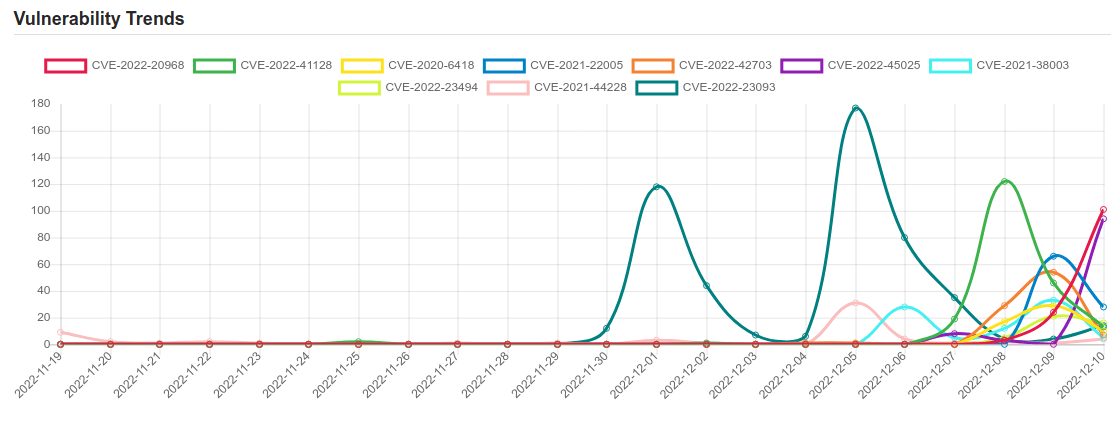Daily Vulnerability Trends: Sun Dec 11 2022

| CVE NAME | CVE Description |
| CVE-2021-44228 | Apache Log4j2 2.0-beta9 through 2.15.0 (excluding security releases 2.12.2, 2.12.3, and 2.3.1) JNDI features used in configuration, log messages, and parameters do not protect against attacker controlled LDAP and other JNDI related endpoints. An attacker who can control log messages or log message parameters can execute arbitrary code loaded from LDAP servers when message lookup substitution is enabled. From log4j 2.15.0, this behavior has been disabled by default. From version 2.16.0 (along with 2.12.2, 2.12.3, and 2.3.1), this functionality has been completely removed. Note that this vulnerability is specific to log4j-core and does not affect log4net, log4cxx, or other Apache Logging Services projects. |
| CVE-2022-23093 | No description provided |
| CVE-2021-26708 | A local privilege escalation was discovered in the Linux kernel before 5.10.13. Multiple race conditions in the AF_VSOCK implementation are caused by wrong locking in net/vmw_vsock/af_vsock.c. The race conditions were implicitly introduced in the commits that added VSOCK multi-transport support. |
| CVE-2022-3786 | A buffer overrun can be triggered in X.509 certificate verification, specifically in name constraint checking. Note that this occurs after certificate chain signature verification and requires either a CA to have signed a malicious certificate or for an application to continue certificate verification despite failure to construct a path to a trusted issuer. An attacker can craft a malicious email address in a certificate to overflow an arbitrary number of bytes containing the `.’ character (decimal 46) on the stack. This buffer overflow could result in a crash (causing a denial of service). In a TLS client, this can be triggered by connecting to a malicious server. In a TLS server, this can be triggered if the server requests client authentication and a malicious client connects. |
| CVE-2022-33942 | Protection mechanism failure in the Intel(R) DCM software before version 5.0 may allow an unauthenticated user to potentially enable escalation of privilege via adjacent access. |
| CVE-2022-36537 | ZK Framework v9.6.1, 9.6.0.1, 9.5.1.3, 9.0.1.2 and 8.6.4.1 allows attackers to access sensitive information via a crafted POST request sent to the component AuUploader. |
| CVE-2021-22555 | A heap out-of-bounds write affecting Linux since v2.6.19-rc1 was discovered in net/netfilter/x_tables.c. This allows an attacker to gain privileges or cause a DoS (via heap memory corruption) through user name space |
| CVE-2022-4262 | Type confusion in V8 in Google Chrome prior to 108.0.5359.94 allowed a remote attacker to potentially exploit heap corruption via a crafted HTML page. (Chromium security severity: High) |
| CVE-2022-3602 | A buffer overrun can be triggered in X.509 certificate verification, specifically in name constraint checking. Note that this occurs after certificate chain signature verification and requires either a CA to have signed the malicious certificate or for the application to continue certificate verification despite failure to construct a path to a trusted issuer. An attacker can craft a malicious email address to overflow four attacker-controlled bytes on the stack. This buffer overflow could result in a crash (causing a denial of service) or potentially remote code execution. Many platforms implement stack overflow protections which would mitigate against the risk of remote code execution. The risk may be further mitigated based on stack layout for any given platform/compiler. Pre-announcements of CVE-2022-3602 described this issue as CRITICAL. Further analysis based on some of the mitigating factors described above have led this to be downgraded to HIGH. Users are still encouraged to upgrade to a new version as soon as possible. In a TLS client, this can be triggered by connecting to a malicious server. In a TLS server, this can be triggered if the server requests client authentication and a malicious client connects. Fixed in OpenSSL 3.0.7 (Affected 3.0.0,3.0.1,3.0.2,3.0.3,3.0.4,3.0.5,3.0.6). |
| CVE-2022-3430 | No description provided |
| CVE-2022-3431 | No description provided |
| CVE-2020-25669 | A vulnerability was found in the Linux Kernel where the function sunkbd_reinit having been scheduled by sunkbd_interrupt before sunkbd being freed. Though the dangling pointer is set to NULL in sunkbd_disconnect, there is still an alias in sunkbd_reinit causing Use After Free. |
| CVE-2022-20968 | No description provided |
| CVE-2022-41128 | Windows Scripting Languages Remote Code Execution Vulnerability. This CVE ID is unique from CVE-2022-41118. |
| CVE-2020-6418 | Type confusion in V8 in Google Chrome prior to 80.0.3987.122 allowed a remote attacker to potentially exploit heap corruption via a crafted HTML page. |
| CVE-2021-22005 | The vCenter Server contains an arbitrary file upload vulnerability in the Analytics service. A malicious actor with network access to port 443 on vCenter Server may exploit this issue to execute code on vCenter Server by uploading a specially crafted file. |
| CVE-2022-42703 | mm/rmap.c in the Linux kernel before 5.19.7 has a use-after-free related to leaf anon_vma double reuse. |
| CVE-2022-45025 | Markdown Preview Enhanced v0.6.5 and v0.19.6 for VSCode and Atom was discovered to contain a command injection vulnerability via the PDF file import function. |
| CVE-2021-38003 | Inappropriate implementation in V8 in Google Chrome prior to 95.0.4638.69 allowed a remote attacker to potentially exploit heap corruption via a crafted HTML page. |
| CVE-2022-23494 | tinymce is an open source rich text editor. A cross-site scripting (XSS) vulnerability was discovered in the alert and confirm dialogs when these dialogs were provided with malicious HTML content. This can occur in plugins that use the alert or confirm dialogs, such as in the `image` plugin, which presents these dialogs when certain errors occur. The vulnerability allowed arbitrary JavaScript execution when an alert presented in the TinyMCE UI for the current user. This vulnerability has been patched in TinyMCE 5.10.7 and TinyMCE 6.3.1 by ensuring HTML sanitization was still performed after unwrapping invalid elements. Users are advised to upgrade to either 5.10.7 or 6.3.1. Users unable to upgrade may ensure the the `images_upload_handler` returns a valid value as per the images_upload_handler documentation. |
A considerable amount of time and effort goes into maintaining this website, creating backend automation and creating new features and content for you to make actionable intelligence decisions. Everyone that supports the site helps enable new functionality.
If you like the site, please support us on Patreon using the button below

To keep up to date follow us on the below channels.





